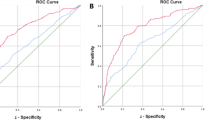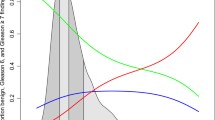Abstract
Aim
To investigate the utility of prostate specific antigen density for detecting prostate cancer in men with serum PSA levels of 4–10 ng/mL.
Methods
Between January 2003 and November 2007, 237 men (aged 48–84 years, median 71) with total PSA levels of 4–10 ng/mL participated in a protocol for prostate cancer screening. Eligible patients were recommended for transrectal ultrasonography (TRUS)-guided prostate biopsies after measuring prostate volumes transrectally. The diagnostic value of PSA levels and the free-to-total PSA ratio (f/tPSA), PSA densities (PSAD) were compared using receiver operating characteristic analysis.
Results
Prostate cancer was diagnosed in 44 (18.6%) of the 237 men who had biopsies. There were significant differences between the groups in the prostate volumes determined by TRUS, PSAD, PSA levels and f/tPSA, whereas there was no significant difference in patient age. The area under the curve (AUC) of PSA (0.6786) and PSAD (0.717) was similar and significantly greater than that of f/tPSA (AUC 0.329). PSAD was a significantly better indicator of prostate cancer than f/tPSA. The sensitivity and specificity of PSA density at a cutoff of 0.134 ng/mL2 was 90 and 33.7%, respectively.
Conclusion
PSAD was a better predictor of prostate cancer in Chinese men with PSA levels of 4–10 ng/mL, especially those who have had prior ultrasound-determined measurements of prostate volume. Our data suggest that different PSAD cutoffs may need to be defined for Chinese.

Similar content being viewed by others
References
Aksoy Y, Oral A, Aksoy H, Demirel A, Akcay F (2003) PSA density and PSA transition zone density in the diagnosis of prostate cancer in PSA gray zone cases. Ann Clin Lab Sci 33:320–323
Allan RW, Sanderson H, Epstein JI (2003) Correlation of minute (0.5 mm or less) focus of prostate adenocarcinoma on needle biopsy with radical prostatectomy specimen: role of prostate specific antigen density. J Urol 170:370–372
Babaian RJ, Toi A, Kamoi K, Troncoso P, Sweet J, Evans R, Johnston D, Chen M (2000) A comparative analysis of sextant and an extended 11-core multisite directed biopsy strategy. J Urol 163:152–157
Benson MC, Whang IS, Pantuck A, Ring K, Kaplan SA, Olsson CA, Cooner WH (1992) Prostate specific antigen density: a means of distinguishing benign prostatic hypertrophy and prostate cancer. J Urol 147:815–816
Cao XL, Gao JP, Han G, Tang J, Hong BF (2006) Relationship between screening by stratifying cases into groups on prostate specific antigen level and the positive rate of transrectal ultrasound guided systematic sextant prostate biopsy. Zhonghua Wai Ke Za Zhi 44:372–375
Carter HB, Pearson JD, Metter EJ, Brant LJ, Chan DW, Andres R, Fozard JL, Walsh PC (1992) Longitudinal evaluation of prostate specific antigen levels in men with and without prostate disease. JAMA 267:2215–2220
Catalona WC, Smith DS, Wolfert RL, Wang TJ, Rittenhouse HG, Ratliff TL, Nadler RB (1995) Evaluation of percentage of free serum prostate specific antigen to improve specificity of prostate cancer screening. JAMA 274:1214–1220
Chang YL, Lin AT, Chen KK, Chang YH, Wu HH, Kuo JY, Huang WJ, Lu SH, Hsu YS, Chung HJ, Chang SC (2006) Correlation between serum prostate specific antigen and prostate volume in Taiwanese men with biopsy proven benign prostatic hyperplasia. J Urol 176:196–199
Coffy DS (2001) Similarities of prostate and breast cancer. evolution, diet, and estrogens. Urology 57(Suppl):31–38
Eskew LA, Bare RL, McCullough DL (1997) Systemic 5 region prostate biopsy is superior to sextant method for diagnosing carcinoma of the prostate. J Urol 157:199–202
Gupta A, Aragaki C, Gotoh M, Masumori N, Ohshima S, Tsukamoto T, Roehrborn CG (2005) Relationship between prostate specific antigen and indexes of prostate volume in Japanese men. J Urol 173:503–506
Lam JS, Cheung YK, Benson MC, Goluboff ET (2003) Comparison of the predictive accuracy of serum prostate specific antigen levels and prostate specific antigen density in the detection of prostate cancer in Hispanic-American and white men. J Urol 170:451–456
NCCN Clinical Practice Guidelines in Oncology (2007) Prostate cancer early detection, version 2
Oesterling JE, Jacobsen SJ, Chute CG, Guess HA, Girman CJ, Panser LA, Lieber MM (1993) Serum prostate specific antigen in a community-based population of healthy men. Establishment of age-specific reference ranges. JAMA 270:860–864
Okihara K, Cheli CD, Partin AW, Fritche HA, Chan DW, Sokoll LJ, Brawer MK, Schwartz MK, Vessella RL, Loughlin KR, Johnston DA, Babaian RJ (2002) Comparative analysis of complexed prostate specific antigen, free prostate specific antigen and their ratio in detecting prostate cancer. J Urol 167:2017–2023
Polascik TJ, Oesterling JE, Partin AW (1999) Prostate specific antigen: a decade of discovery-what we have learned and where we are going. J Urol 162(2):293–306
Sakai I, Harada K, Hara I, Eto H, Miyake H (2004) Limited usefulness of the free-to-total prostate specific antigen ratio for the diagnosis and staging of prostate cancer in Japanese men. Int J Clin Oncol 9:64–67
Schmid HP, McNeal JE, Stamey TA (1993) Observations on the doubling time of prostate cancer. The use of serial prostate specific antigen in patients with untreated disease as a measure of increasing cancer volume. Cancer 71:2031–2040
Sözen S, Eskicorapci S, Küpeli B, Irkilata L, Altinel M, Ozer G, Uygur C, Alkibay T, Ozen H (2005) Complexed prostate specific antigen density is better than the other PSA derivatives for detection of prostate cancer in men with total PSA between 2.5 and 20 ng/mL: results of a prospective multicenter study. Eur Urol 47:302–307
Terris MK, Stamey TA (1991) Determination of prostate volume by transrectal ultrasound. J Urol 145:984–987
Veneziano S, Pavlica P, Compagnone G, Martorana G (2005) Usefulness of the (F/T)/PSA density ratio to detect prostate cancer. Urol Int 74:13–18
Xie LP, Bai Y, Zhang XZ, Zheng XY, Yao KS, Xu L, Zeegers MP (2007) Obesity and benign prostatic enlargement: a large observational study in China. Urology 69:680–684
Yamamoto S, Kin U, Nakamura K, Hamano M, Nishikawa Y, Takenouchi T, Maruoka M (2005) Transperineal ultrasound-guided 12-core systematic biopsy of the prostate for patients with a prostate specific antigen level of 2.5–20 ng/mL in Japan. Int J Clin Oncol 10:117–121
Zhao YR, Xu Y, Zhang D, Chang JW, Zhang SM, Shi QD, Sun G, Han RF, Yao QX, Ma TX (2005) The predictive value of serum prostate specific antigen, prostate specific antigen density and prostate specific antigen transition zone density in prostate biopsy. Chin J Urol 26:622–625
Zlotta AR, Djavan B, Marberger M, Schulman CC (1997) Prostate specific antigen of the transition zone: a new parameter for prostate cancer prediction. J Urol 157:1315–1321
Acknowledgments
We would like to thank Dr. Long-Cheng Li from the University of California San Francisco for critical reading of this manuscript and Drs. Xian-Hong Huang from the Department of Social Medicine and Health Service Management, Zhejiang University School of Medicine for assistance with statistical analysis.
Author information
Authors and Affiliations
Corresponding author
Rights and permissions
About this article
Cite this article
Zheng, XY., Xie, LP., Wang, YY. et al. The use of prostate specific antigen (PSA) density in detecting prostate cancer in Chinese men with PSA levels of 4–10 ng/mL. J Cancer Res Clin Oncol 134, 1207–1210 (2008). https://doi.org/10.1007/s00432-008-0400-8
Received:
Accepted:
Published:
Issue Date:
DOI: https://doi.org/10.1007/s00432-008-0400-8




